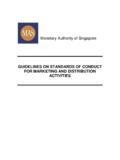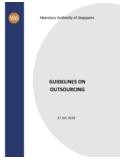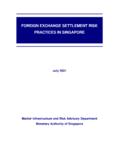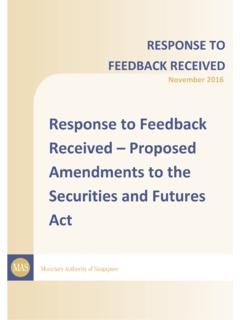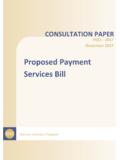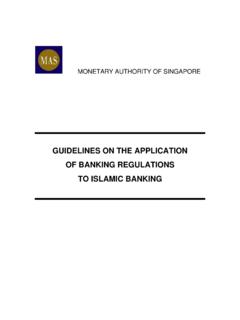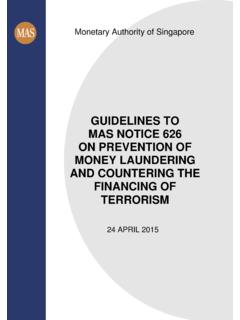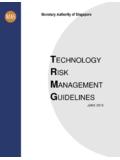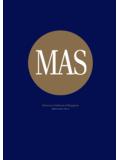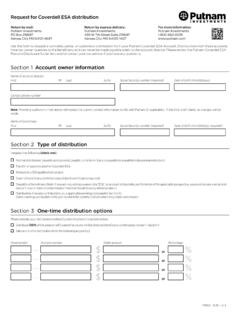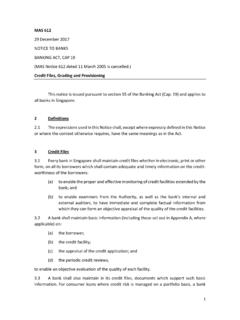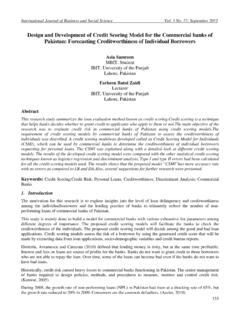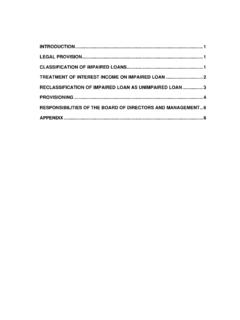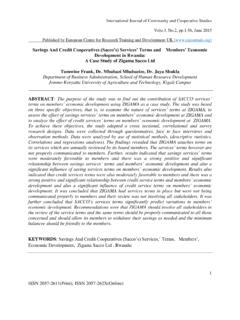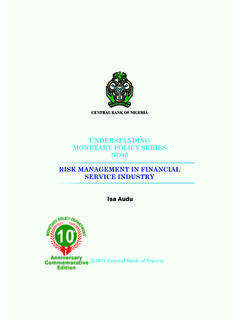Transcription of MAS 612 final
1 mas 612 11 March 2005 NOTICE TO BANKS BANKING ACT, CAP 19 (MAS Notice 612 dated 30 December 2004 is cancelled.) Credit Files, Grading and Provisioning This notice is issued pursuant to section 55 of the Banking Act (Cap. 19) and applies to all banks in Singapore. 2 Definitions The expressions used in this Notice shall, except where expressly defined in this Notice or where the context otherwise requires, have the same meanings as in the Act. 3 Credit Files Every bank in Singapore shall maintain credit files whether in electronic, print or other form, on all its borrowers which shall contain adequate and timely information on the credit-worthiness of the borrowers: (a) to enable the proper and effective monitoring of credit facilities extended by the bank; and (b) to enable examiners from the Authority, as well as the bank s internal and external auditors, to have immediate and complete factual information from which they can form an objective appraisal of the quality of the credit facilities.
2 A bank shall maintain basic information (including those set out in the Appendix, where applicable) on: (a) the borrower; (b) the credit facility; 2 (c) the appraisal of the credit application; and (d) the conduct of the account, to enable an objective evaluation of the quality of each facility. A bank shall also maintain in its credit files, documents which support such basic information. For consumer loans where credit risk is managed on a portfolio basis, a bank shall maintain information on at least the borrower, credit facility and its appraisal of the credit application. The information in the credit files shall be made available in English. 4 Grading of Credit Facilities A bank in Singapore shall conduct regular and systematic reviews of all credit facilities (including off balance-sheet items) that it has extended to its borrowers.
3 A bank shall exercise its judgment in deciding the frequency of reviews for the various types of credit facilities. In general, facilities deemed to be of higher risk or showing signs of deterioration should be placed on a shorter review cycle. For consumer loans with homogeneous characteristics, a bank may perform credit reviews on a portfolio basis. A bank shall categorise the credit facilities based on its assessment of the ability of the borrower to repay from the normal sources of income of that borrower. At a minimum, a bank shall categorise the credit facilities into five credit grades, namely (a) pass, (b) special mention, (c) substandard, (d) doubtful and (e) loss .
4 The last three credit grades are considered as classified grades. The description of each of the credit grades is as follows: (a) Pass: this indicates that timely repayment of the outstanding credit facility is not in doubt. Repayment is prompt and the credit facility does not exhibit any potential weakness in repayment capability, business, cash flow or financial position of the borrower. (b) Special Mention: This indicates that the credit facility exhibits potential weaknesses that, if not corrected in a timely manner, may adversely affect repayment by the borrower at a future date, and warrant close attention by a bank. Characteristics of special mention credit facilities include the following: 3 (i) a declining trend in the operations of the borrower that signals a potential weakness in the financial position of the borrower, but not to the point that repayment is jeopardised; (ii) economic and market conditions that may unfavourably affect the profitability and business of the borrower in the future.
5 (c) Substandard: this indicates that the credit facility exhibits definable weaknesses, either in respect of the business, cash flow or financial position of the borrower that may jeopardise repayment on existing terms. Characteristics of substandard credit facilities include the following: (i) inability of the borrower to meet contractual repayment terms of the credit facility; (ii) unfavourable economic and market conditions or operating problems that would affect the profitability and business of the borrower in the future; (iii) weak financial condition or the inability of the borrower to generate sufficient cash flow to service the payments; (iv) difficulties experienced by the borrower in repaying other credit facilities granted by the same bank, or by other financial institutions (where such information is available).
6 (v) breach of any key financial covenants by the borrower. A bank shall assess the severity of each weakness exhibited by the credit facility and consider whether the weakness, when considered singly and in combination with other weaknesses, would adversely affect the repayment ability of the borrower. (d) Doubtful: this indicates that the outstanding credit facility exhibits more severe weaknesses than those in a substandard credit facility, such that the prospect of full recovery of the outstanding credit facility is questionable and the prospect of a loss is high, but the exact amount remains undeterminable as yet. Consumer loans past due for 120 days or more, but less than 180 days fall under this classification.
7 4 (e) loss : this indicates that the outstanding credit facility is not collectable, and little or nothing can be done to recover the outstanding amount from any collateral or from the assets of the borrower generally. Consumer loans past due for 180 days or more fall under this classification. Based on repayment conduct, a bank shall, at the minimum, classify every credit facility: (a) where the principal or interest or both is past due for more than 90 days; (b) in the case of a revolving credit facility (such as an overdraft), where the outstanding amount, including interest, has remained in excess of the approved limit for a period of more than 90 days; or (c) where the amount is past due or the outstanding amount has been in excess of the approved limit for 90 days or less, if the credit facility exhibits weaknesses that render a classification appropriate according to the credit grading framework.
8 For credit facilities with repayments on a quarterly, semi-annual or longer basis, a bank shall classify such a credit facility as soon as a default occurs, unless the credit facility does not exhibit any weakness that would render it classified according to the credit grading framework set out in paragraph A credit facility is restructured when a bank grants concessions to a borrower because of a deterioration in the financial position of the borrower or the inability of the borrower to meet the original repayment schedule. The revised repayment terms relating to the interest or repayment period, are normally considered as non-commercial by a bank.
9 A bank shall place a restructured credit facility on the appropriate classified grade depending on its assessment of the financial condition of the borrower and the ability of the borrower to repay based on the restructured terms. For any credit facility which has been classified according to the requirements set out in paragraph ( classified credit facilities ), a bank may use split credit grades only if certain portions of a facility are likely to be recoverable from the realisation of collateral. If the amount recoverable is considered insufficient to cover the entire amount outstanding, the portion of the credit facility covered by the amount realisable shall be graded "substandard" and the remaining portion shall be graded "doubtful" or loss , where appropriate.
10 5 Every bank in Singapore is encouraged to use internal credit rating systems to categorise its credit facilities. Such internal ratings should be an integral part of the credit risk management framework of the bank for assessing, monitoring and controlling the quality structure of the loan portfolios. Independent validation of the rating systems should also be performed to ascertain the accuracy and reliability of these systems in measuring the quality of the bank s loan portfolios. For the purpose of reporting to the Authority, the internal ratings from these systems shall be mapped to the 5 credit grades listed in paragraph 5 Upgrading of Credit Facilities Upgrading of any credit facility shall be supported by a credit assessment of repayment capability, cash flows and financial position of the borrower in line with the credit grading framework set out in paragraph A bank shall exercise prudence in the upgrading of any credit facility and be satisfied that the credit facility that it intends to upgrade has exhibited a sustained trend of improvement to justify the improved credit grading.
